When The Iberian Derby appeared on the fixtures list, minds immediately raced to their last match. An epic World Cup 2018 group stage encounter ended in a 3-3 draw. Cristiano Ronaldo was the talk of Sochi, producing a hat trick.
Much has changed between the two games. Weeks after that World Cup game, Ronaldo made his transfer from Real Madrid to Juventus, Renato Sanches has moved on from Bayern Munich, Wolves can field an all-Portuguese starting XI, Sergio Ramos is Spain’s caps leader and Luis Enrique has given a number of debuts to top young talents.
In this tactical analysis, we’ll examine the tactics that allowed Spain to dominate the first 20 minutes of the match, as well as the Portuguese response. Though Spain enjoyed 66% possession, it was Portugal that generated the highest quality opportunities. This analysis will detail why Portugal’s counterattacking was so effective.
Lineups
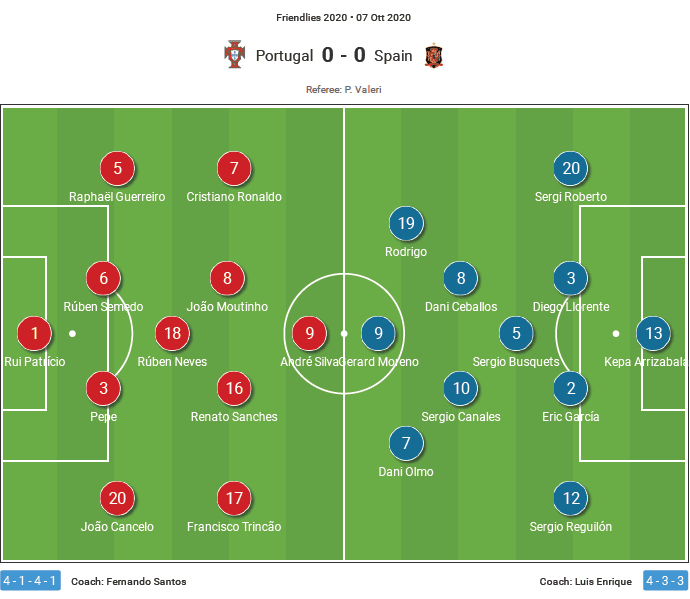
Long-time Portugal coach, Fernando Santos, set the team out in a 4-1-4-1, handing the goalkeeping reigns back to Rui Patrício after Anthony Lopes commanded the net in the previous international window. The seemingly evergreen Pepe manned the backline with Rúben Semedo to his left, then Raphaël Guerreiro and João Cancelo on the wings. Rúben Neves was the pivot with his Wolves teammate, João Moutinho and Sanches in front of him. Barcelona wunderkind, Francisco Trincão, joined Ronaldo and André Silva in a very fluid approach up top.
Enrique went with a 4-3-3, giving the embattled Kepa Arrizabalaga his 11th cap. From right to left, the backline consisted of Sergi Roberto, Diego Llorente, Eric García and Sergio Reguilón. Sergio Busquets played the pivot, flanked by Dani Ceballos and Serio Canales. Up top, the new Leeds man, Rodrygo, started on the right, while RB Leipzig’s Dani Olmo played on the left with Villarreal’s Gerard Moreno in the middle. One of the highlights in the match were the Spanish debuts for Jose Campaña and Adama Traore.
Spain’s early domination
From the opening minutes of the game, Spain’s tactics were clear. Much like the Spanish teams of the recent past, the intent was to overload in order to unbalance the defence. This was a fast-paced game, highlighted by Spain’s 18.6 passes per minute and 6.6 PPDA (passes allowed per defensive action). Add in the 66% possession and 94% accuracy on 707 passes and you get the general picture of Spain’s tactics. Dominate the ball, pull Portugal out of their press and keep Portugal from enjoying time on the ball.
Of those 707 attempted passes, 46% (326) were lateral, 16% went back and 12% were progressive. In their attempts to manipulate and break Portugal’s defensive shape, lateral ball circulation was key, overloading near the ball to force the defensive imbalance. Once Portugal was imbalanced, a lateral pass generally preceded the vertical look.
Early in the match, Spain really had Portugal on their heels. In the opening 20 minutes, Spain was able to continuously unlock the Portuguese defence, drawing them into one wing to then attack elsewhere.
Spain’s success in unbalancing the Portuguese defence resulted in two shots within the first two minutes of the match. In the build-up to the shots, we saw Spain overload on the right-hand side, drawing in the opposition, resulting in a 4v4. The image below shows the central outlet sitting in a pocket of space, but there’s also the deep drop, which is unopposed. With the Portuguese defence increasing pressure near the ball, the Spanish were cued to end the rondo and play out of pressure.
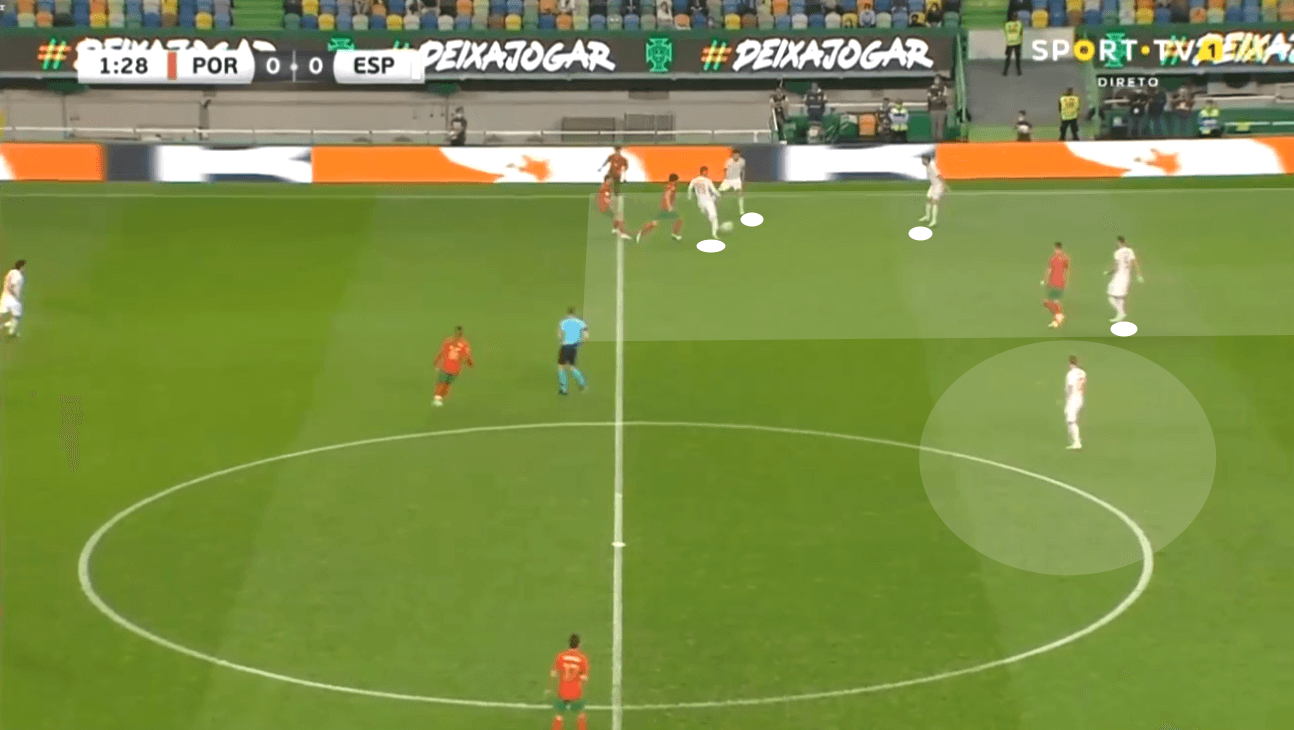
The pass travelled on a negative diagonal towards the central channel. García received the pass and aggressively progressed on the dribble.
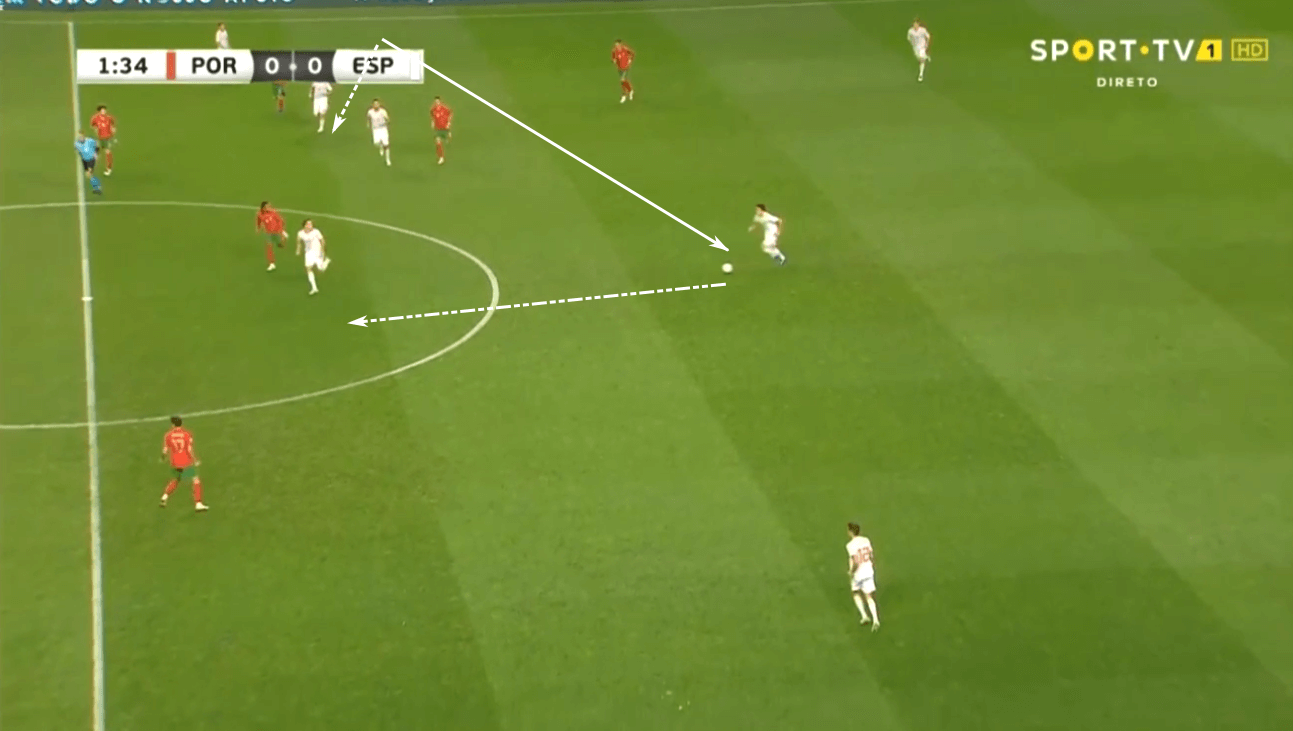
With Sanches forced to step into a first defender role, space emerged between the lines. Moreno stepped into that space, completing the switch of play to the left-wing for Olmo.
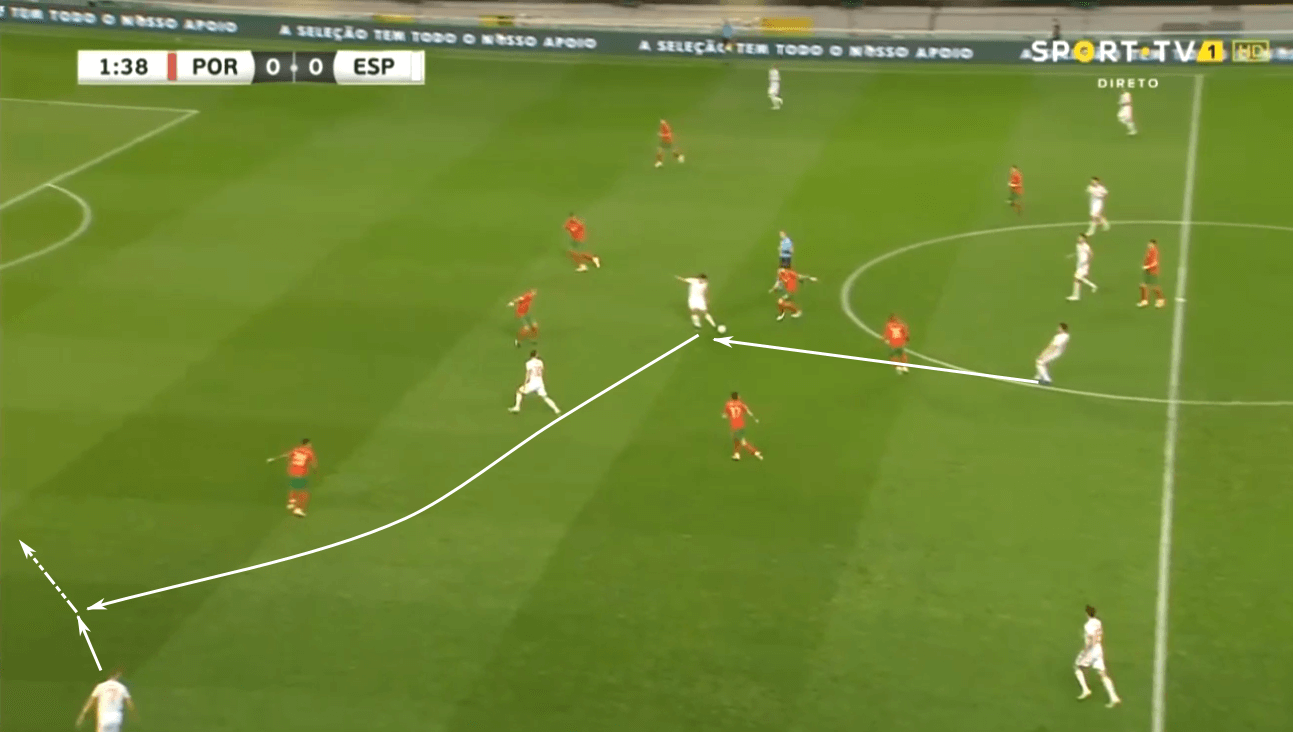
The Leipzig man dribbled into the box, drawing in the scrambling Portuguese defence, before returning the ball to Moreno, who beat Semedo on the dribble. Only a strong save from Patrício kept Spain off the scoreboard.
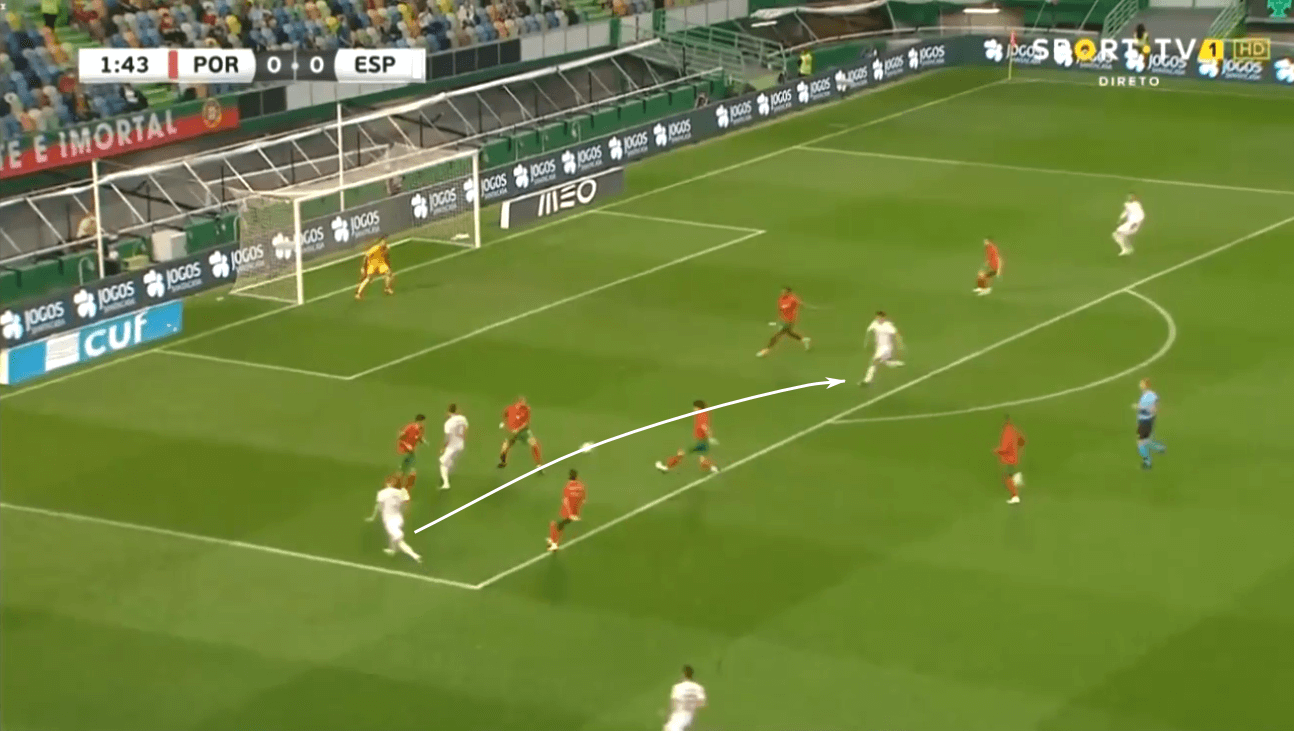
While the overload and switch was a major positive for Spain, they were also highly effective playing between the lines. All three forwards are very comfortable dropping into midfield to linking play. Additionally, both Ceballos and Canales enjoy rotating with the forwards. In the early stages of the match, that interchange was very evident.
Typically occurring in two of the three vertical channels, thus ensuring qualitative superiority through the overload. In order to create the space they wanted to attack, the ball carrier and his immediate options (the second attackers) engaged the defence. By drawing in the defender, they decreased the spatial coverage of the defence. Once pockets of space emerged, a player from outside of that rondo would drop into a pocket of space and receive.
The image below manifests this point. Canales has the ball near-immediate support to his right, as well as a deeper option on the touchline, which keeps the defender wide. That opens up a pocket of space for Olmo.
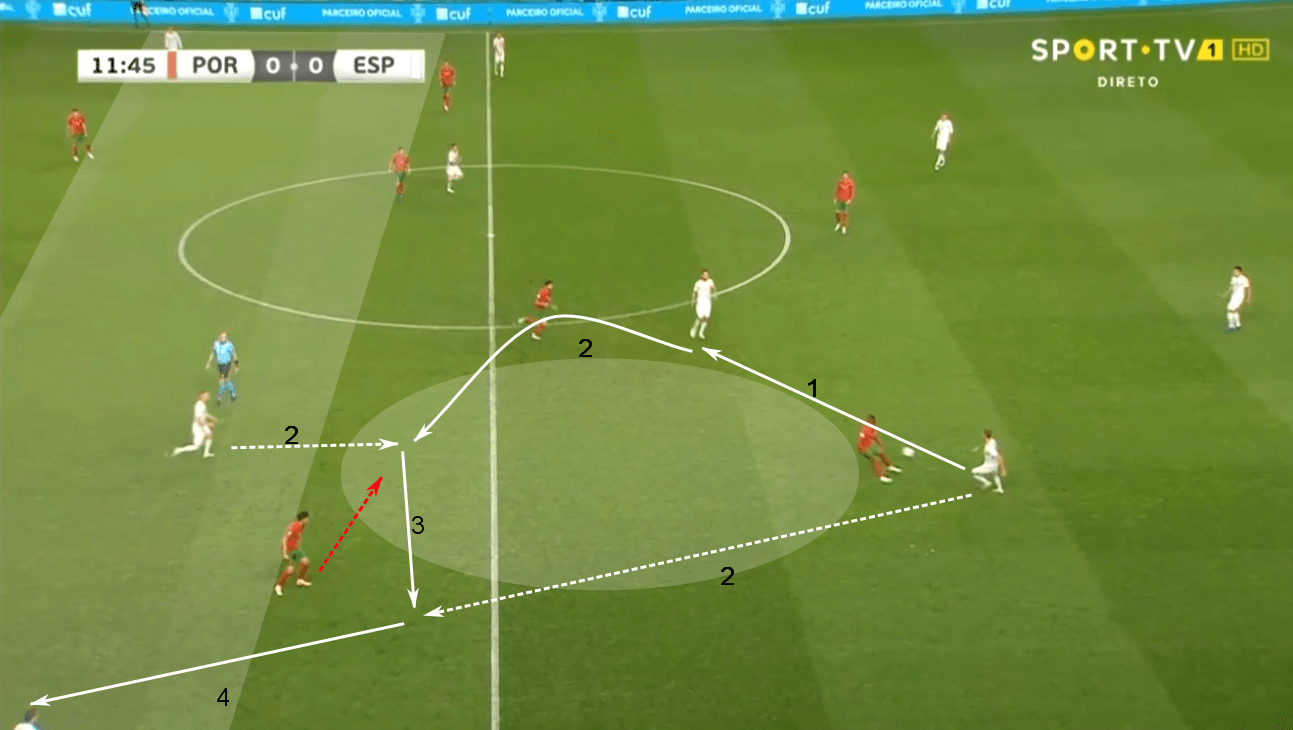
A quick sequence of passes allows Spain to free up Reguilón on the wing. Olmo runs parallel to him in the half space. Reguilón passed to Olmo, who read the run of Moreno, cueing the central progression and shot.
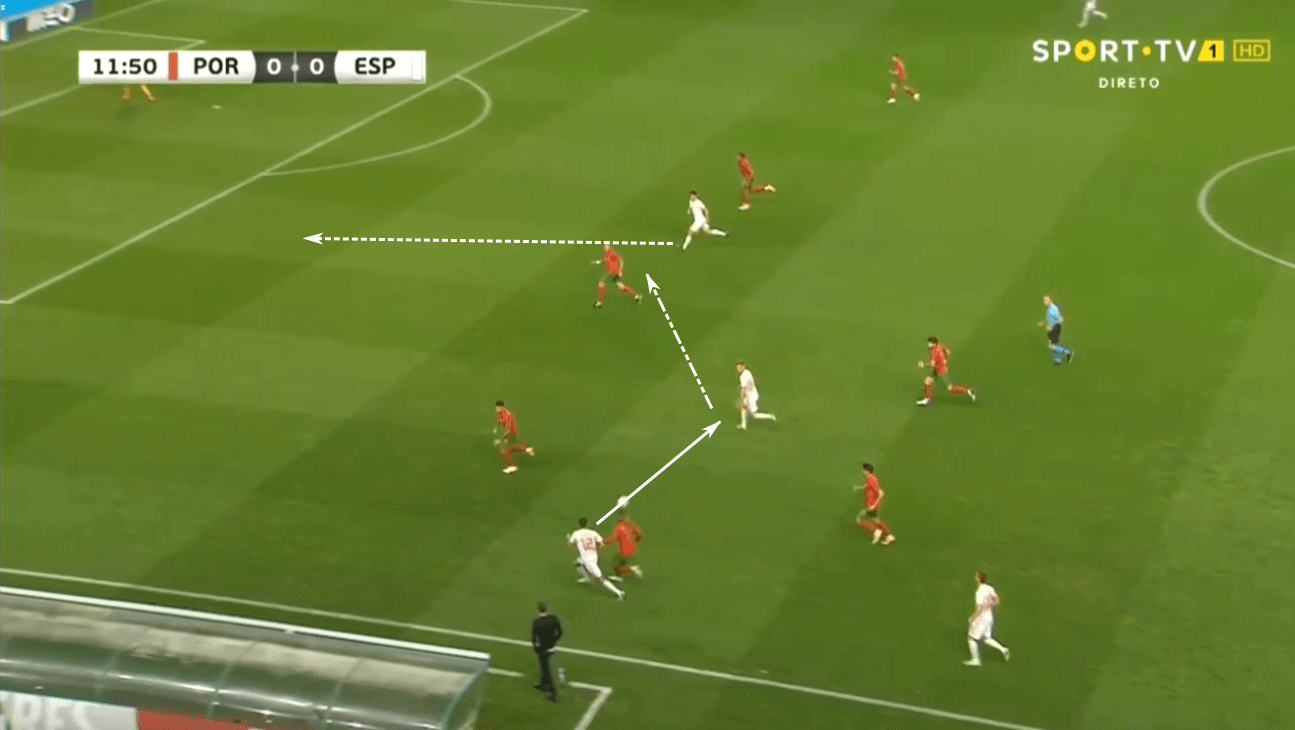
Portugal tightened the lines
After the first 20 minutes, Portugal started to pick up on the starting points and rotations that were breaking them down. To counter Spain’s overloads, Silva dropped into the midfield, leaving Ronaldo as the lone high target.
Within the 4-5-1, Portugal was more effective in managing the space between the lines, funnelling play into the wings and reduce the number of outlets for the ball-carrier. Portugal was much more effective in reducing Spain’s progression, instead, forcing their Iberian neighbours backwards. When Spain did try to play through the middle, Silva and the three central midfielders denied space for progression.
The improvement was impressive. Over the first 20 minutes, Spain took eight shots, resulting in a 0.66 xG. Over the final 70+ minutes, the Portuguese managed to hold their opponent to 0.49 xG on seven shots.
Below, the tighter marking and greater connectivity is immediately apparent. With Silva offering support in the midfield, he blocked off an additional passing lane while pressuring the ball-carrier. Marking in the immediate vicinity of the ball was much easier for Santos’ men. That compact block forced García to play back to Llorente.
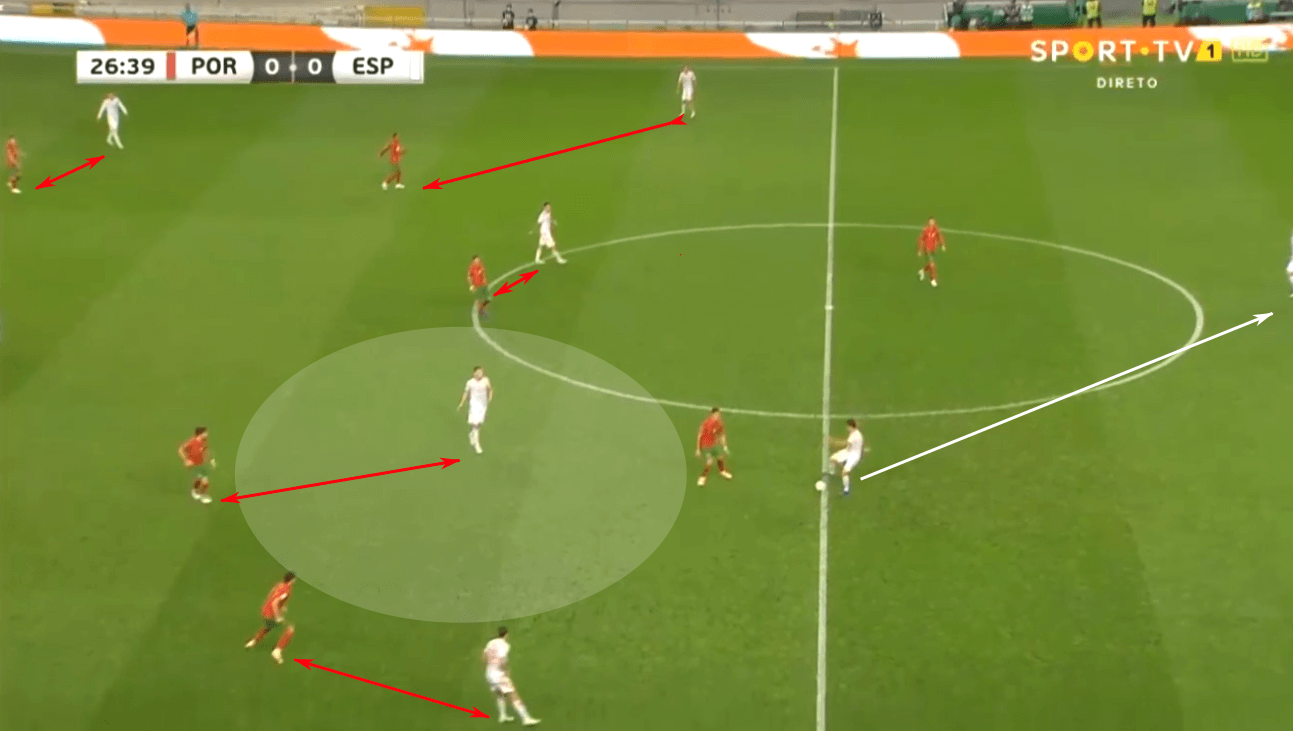
The switch of play to Roberto was accompanied by quick pressure from Sanches, leading to the Barcelona defender’s attempted ball over the top. Cancelo saw it all the way, easily heading the ball into the path of Moutinho.
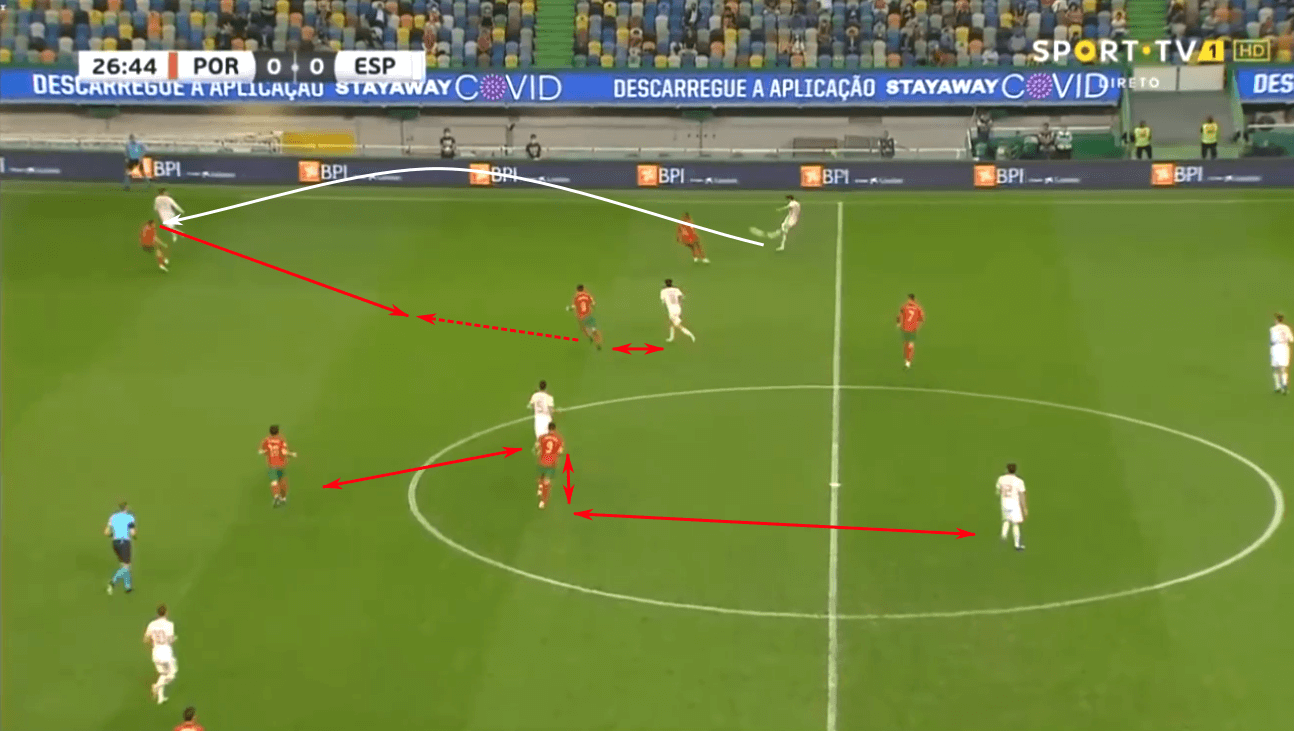
Over the remaining 70+ minutes, Spain was able to break into the space between the lines, but Portugal’s recovery defence was spectacular. With Neves stepping in line with his other midfielders, Moutinho and Sanches were aware that they would occasionally need to track runners targeting the space behind Neves, but the younger Wolves midfielder was also quicker to backtrack.
In the image below, Portugal’s midfield line is flat with Sanches and Trincão positioned wide of their nearest opponent. As Busquets played into Ceballos, the Arsenal midfielder dribbled into the available space.
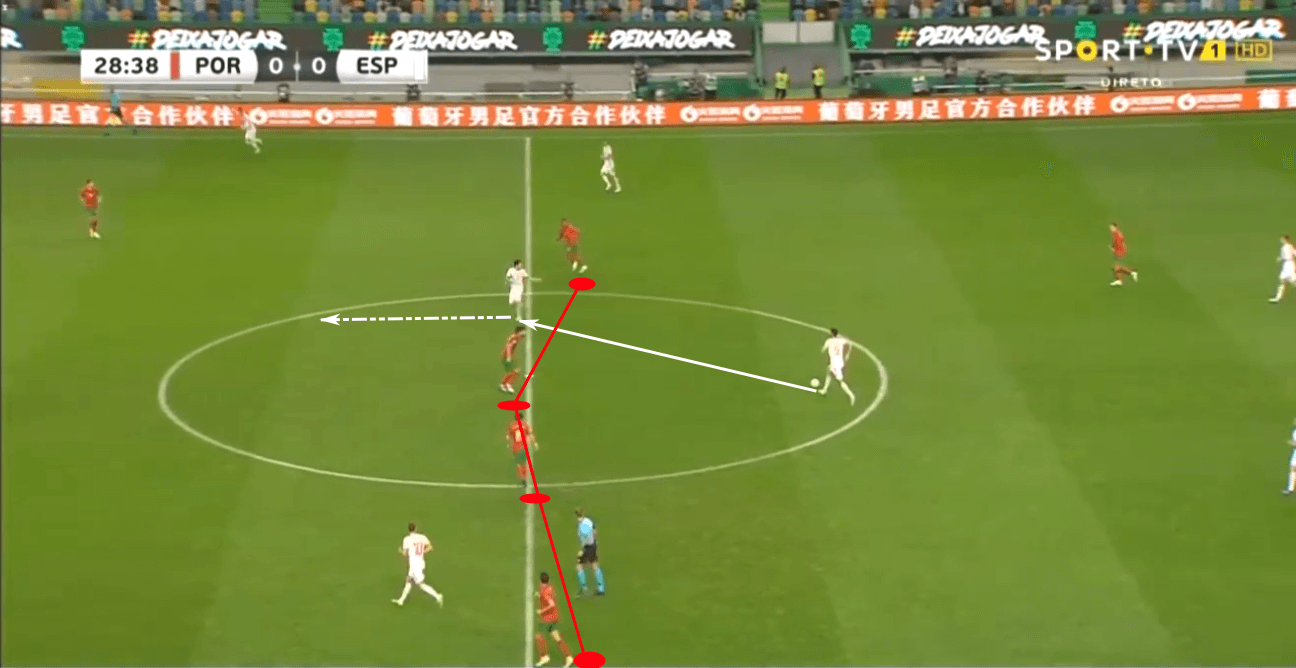
Feeling the pressure from Neves, Ceballos released his pass sooner than he would have liked, resulting in a Cancelo interception.
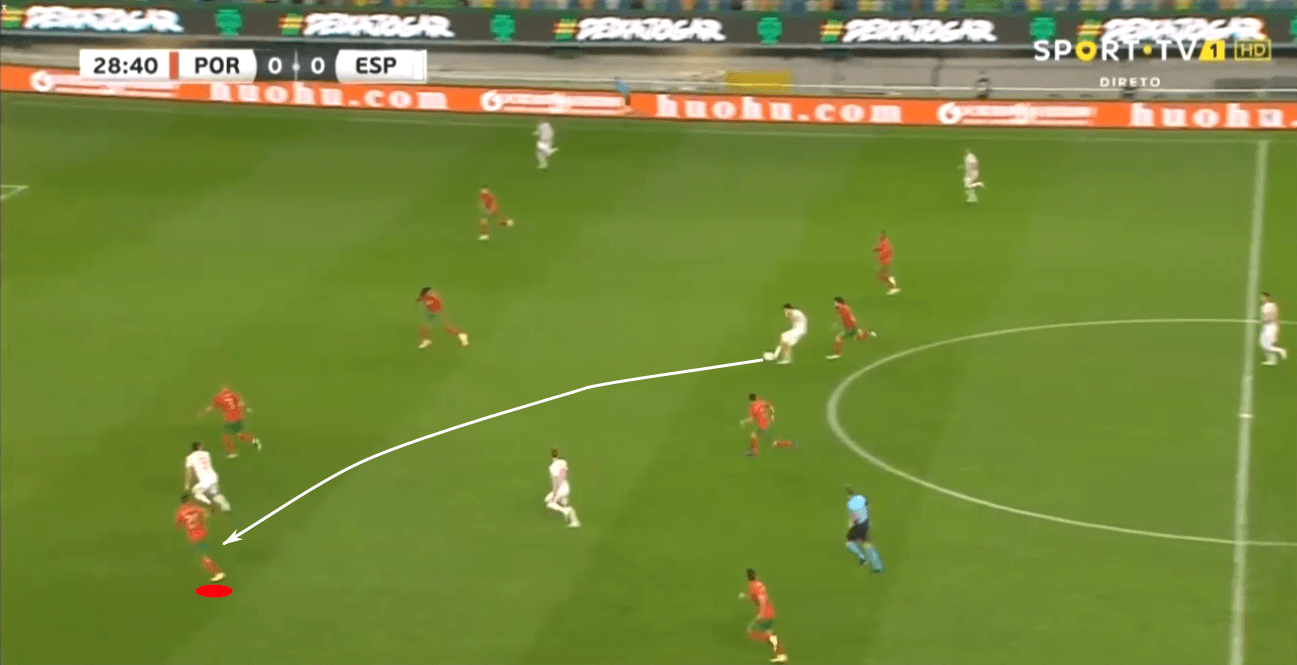
Notice the Portuguese backline has eliminated an easy pass forward. Additionally, the quick recovery from Neves forced Ceballos to play forward before he could engage the backline. Without the need to step forward to pressure Ceballos, the backline could focus on cutting out his forward pass. Since they were unengaged, the interception was relatively straightforward.
Another tactic that helped Portugal initiate from defence was their man-marking in the high press. One thing we saw from Portugal throughout the match was a commitment to getting numbers behind the ball, ensuring they engaged from a position of strength. While the approach was largely zonal, it transitioned into a man-marking scheme in the high press.
The example below shows Portugal forcing Kepa to take on the deep-lying playmaking responsibilities. Each red shirt is close enough to a white shirt to effectively remove that passing option.
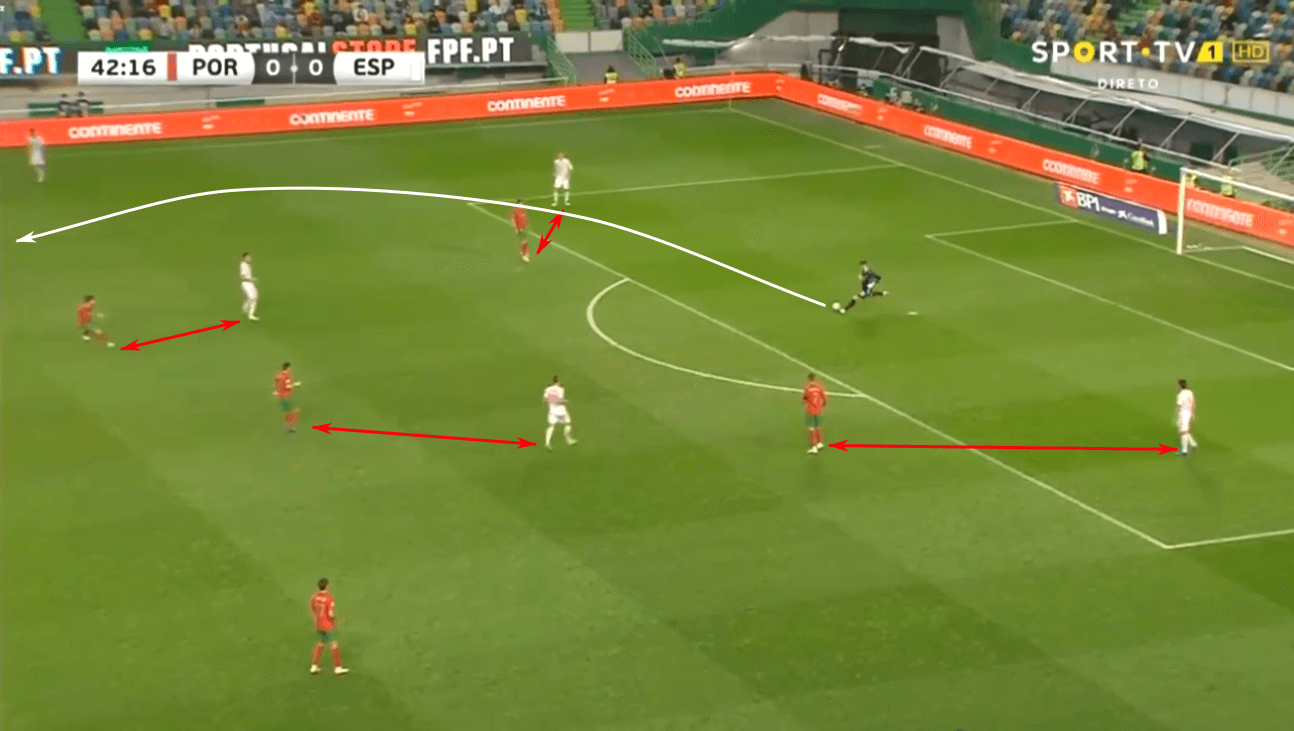
With the closest options out of the equation, Kepa was forced into longer distributions. Pepe won the header in this case, reclaiming possession for his side, but, on the whole, the tactic had limited success as Kepa completed 38 of 40 (95%) passes on the night. Most of those passes were within his own third, going two for four in distributions beyond the defensive third. That goes to show Spain was disciplined in their build-up, accepting the risk of playing through Portugal’s high press.
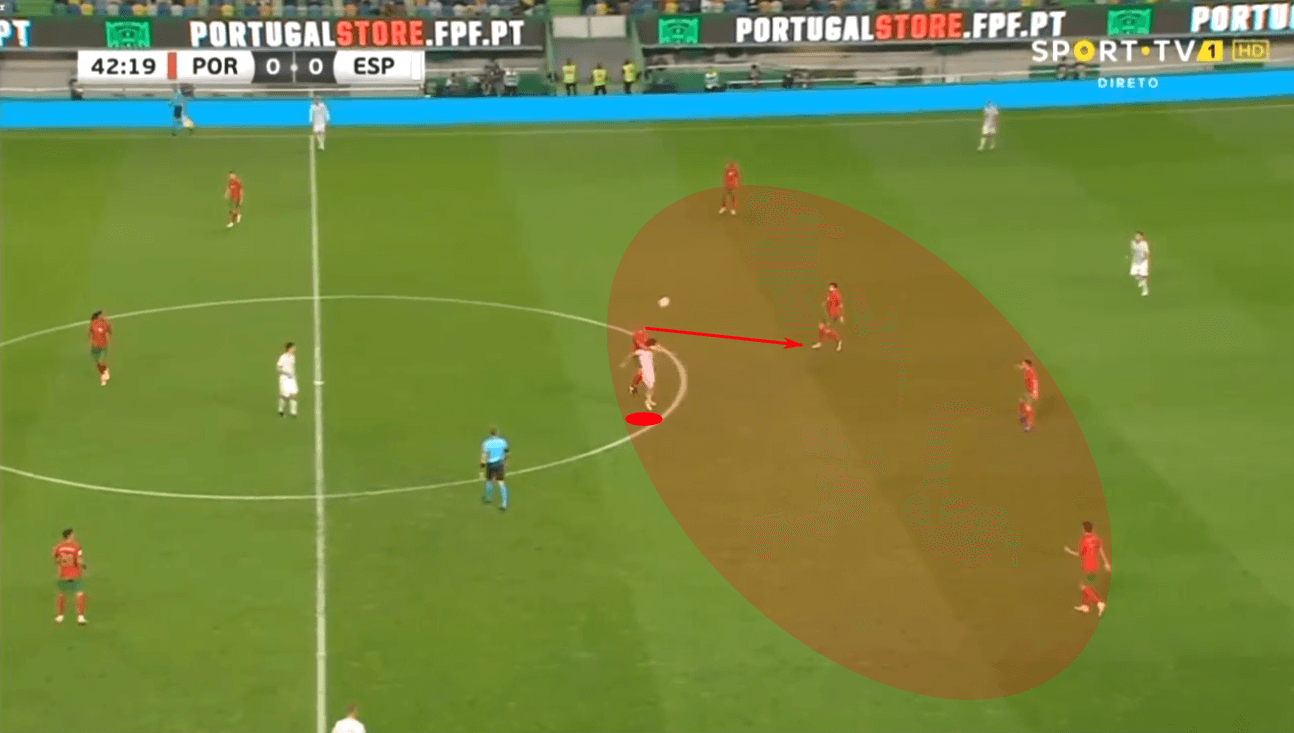
All tactical adjustments considered, Portugal was mostly able to limit the potent Spanish attack to long-range shots and half chances. Looking at Spain’s shooting map, all shots from nine onwards come after the first 20 minutes.
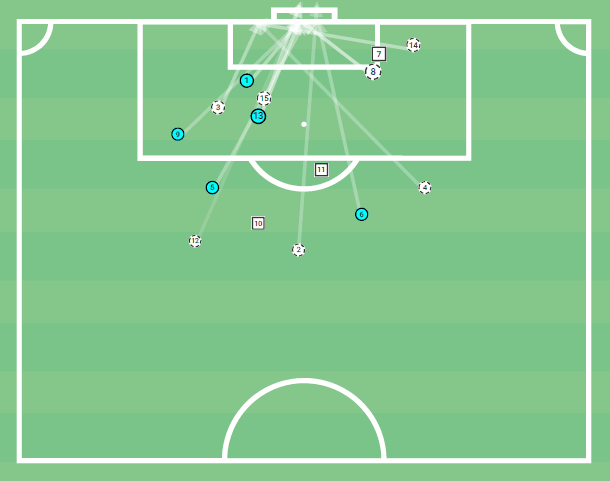
Shot 15 is Ramos’ header from a corner kick while 13 is a shot on goal from Olmo, which required a nice save from Patrício. Other than those two chances, distances and angles worked in Portugal’s favour.
Portugal’s counterattacking success
With Spain owning the bulk of possession, Portugal was willing to remain organised and patiently await counterattacking opportunities. On the day, Portugal recorded four counterattacks to Spain’s zero. Of the home side’s 60 open play possessions, 28 were short (0-10 seconds) attacks, 19 were medium (10-20 seconds), 12 were long (20-45 seconds) and only one was very long (45+ seconds). In contrast, Spain registered 24 long and 12 very long attacks.
Spain’s aggressive and efficient counterpressing was one of the reasons for Portugal’s high number of short and medium attacks. The other reason was Portugal’s desire to attack an expansive rest defence. Enrique’s side, while overloaded near the ball, was expansive elsewhere. In transitional moments, the Portuguese attack was very direct in its move toward goal, using ground passes and dribble penetration to progress.
Portugal’s fluid rotations among the four midfielders and forward make the starting points map, which is based on the average location of a player’s first touch, very tricky.
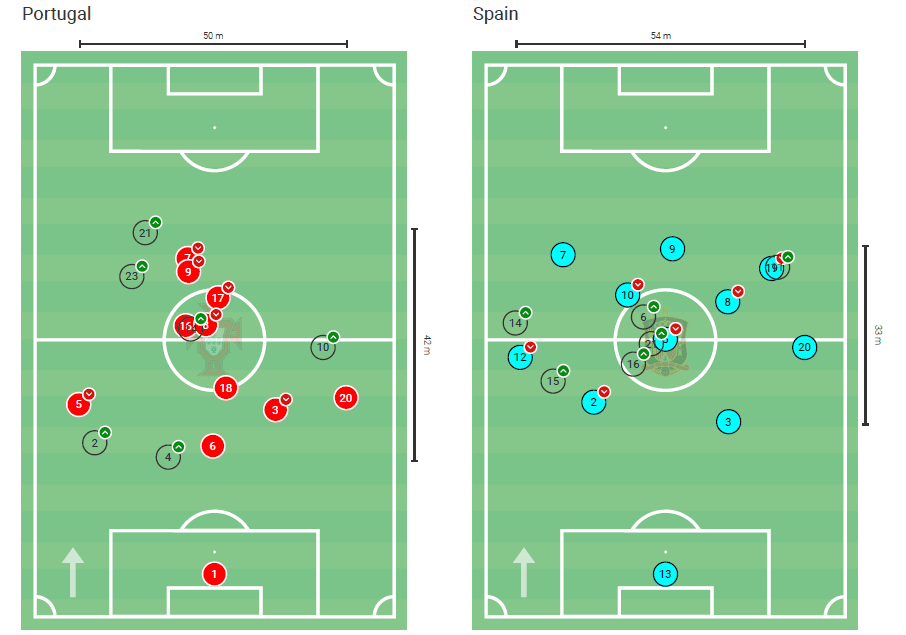
Based purely on the map, you’d get the impression that the Portuguese were a positional mess. Analysis of the footage, it’s testament to the fluidity of the attack and commitment to the counterattacking tactics. Bernardo Silva’s entry also pushed Trincão to the left, evening out the youngster’s positional starting point.
On the flipside, Spain’s positional play was very reliable. Looking at the map, you can pick out the formation and role immediately. The obvious positive is that each player will have an understanding of where his teammates are, making possession a little easier to manage. It also allows for more freedom within the role. The obvious downside is that the rigidity of the system can work against the team, especially once the opposition solves the most pressing dilemmas. That’s what happened in this match.
With Portugal initiating play from their defensive structure, Ronaldo was usually the lone high target. Given his tendency to start in the left half space, most of Portugal’s attacks were funnelled to the left, and they were particularly dangerous from that side too.
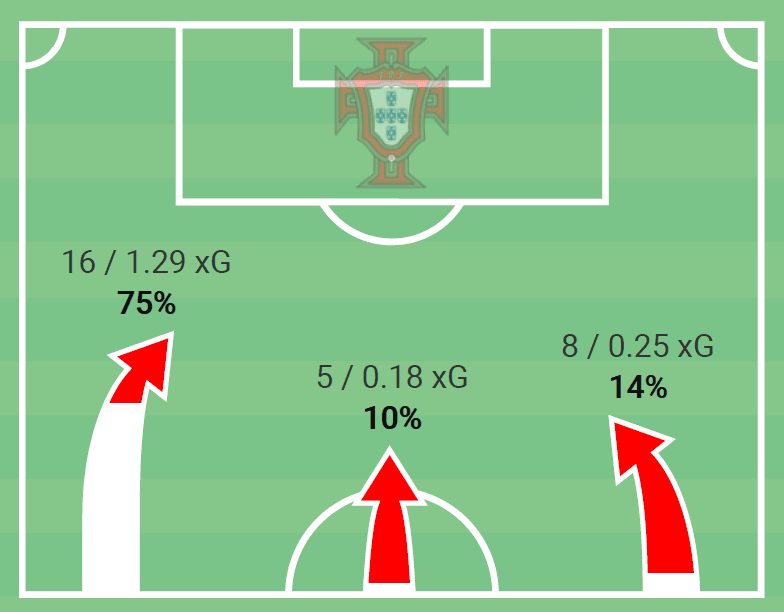
The sequence below offers an opportunity for an analysis of Portugal’s counterattacks. Upon gaining possession, the centrally overloaded Portuguese midfield would quickly combine to break the initial spell of pressure and get the ball to someone who was positioned to play forward. Here we see Neves playing William Carvalho, who split the defence with a pass to Trincão. Notice Ronaldo at the bottom of the image.
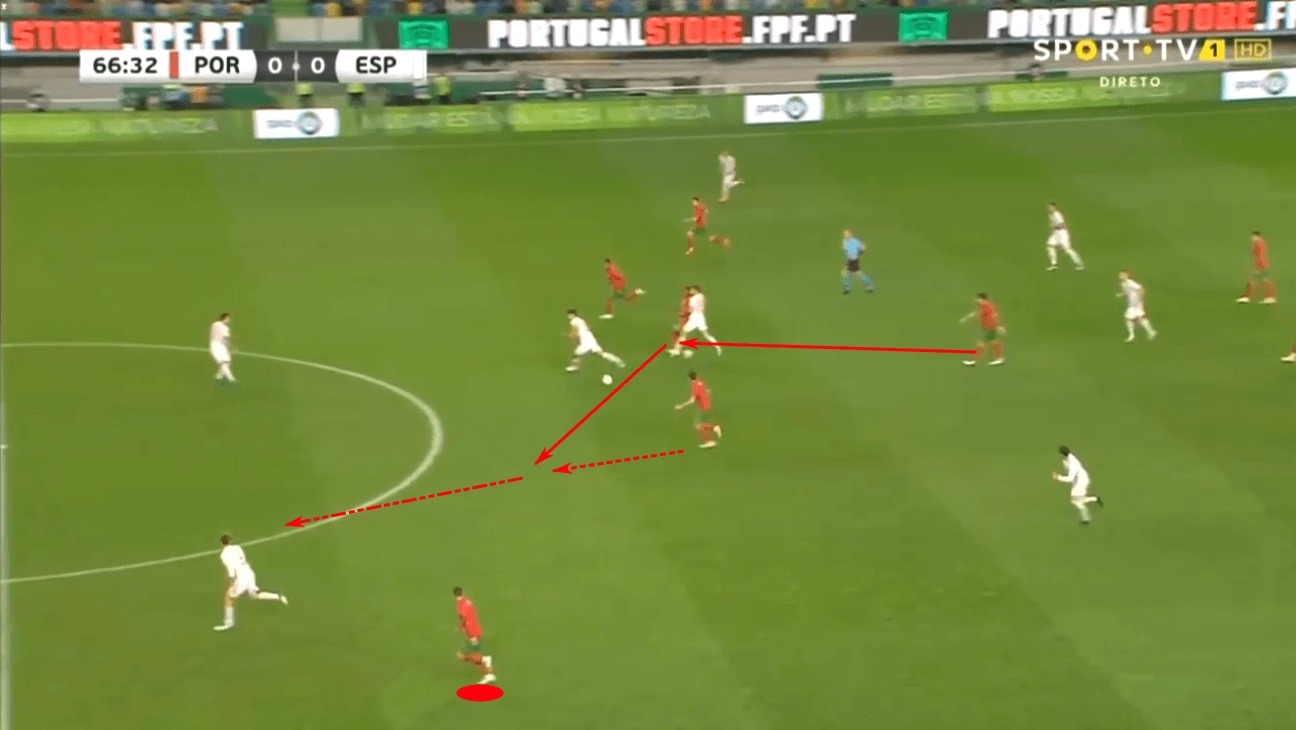
Trincão releases the pass to Ronaldo, Portugal’s highest player on the pitch. On the far side, Sanches is pushing forward to join Ronaldo in the dash towards goal.
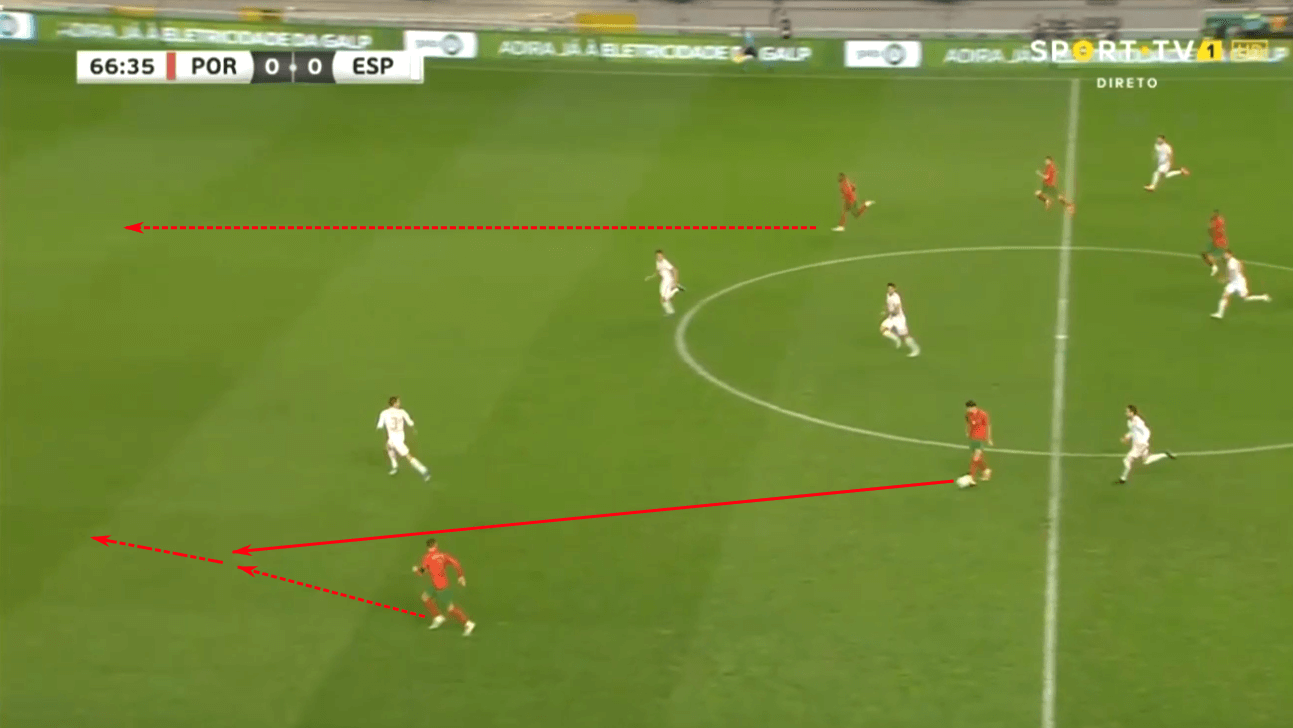
As he nears the box, the Spanish players must assume he’s going to attempt the shot. Cutting in from the left and striking the ball with his right foot is textbook Ronaldo. Instead, the Juventus man sent a beautiful trivela right into the path of Sanches. The 2016 UEFA Golden Boy award winner struck a venomous first-time volley off the crossbar, giving Portugal their second rejection via the top bar.
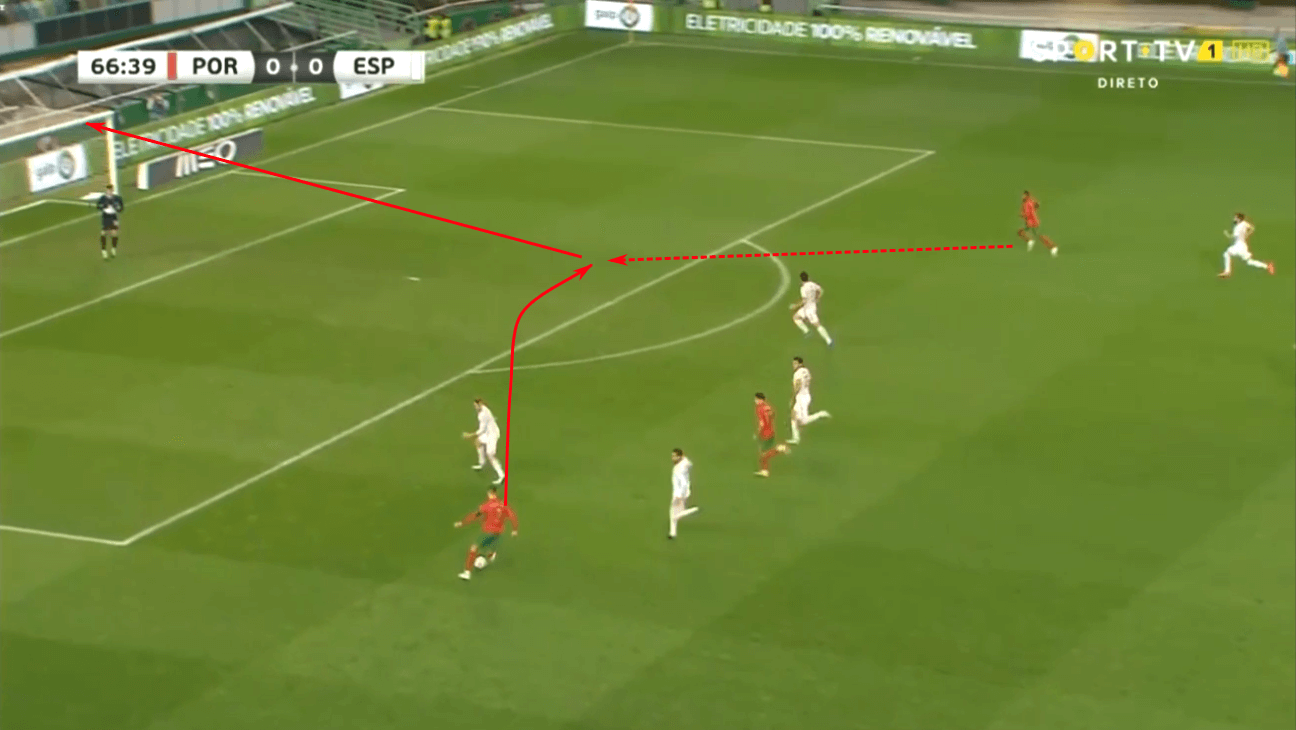
Portugal will certainly be disappointed with their finishing. Out of their 11 shots, they managed 1.71 xG, giving them a very high expected goal average of 0.16 per shot. For context, Spain only had two shots at 0.16 xG or better. The crossbar came to Kepa’s aid twice, but a few really high-quality opportunities will stand out for Santos and the squad.
Conclusion
With a 0-0 scoreline in the latest iteration of the Iberian Derby, the teams now have three consecutive draws, though the last 0-0 affair ended 4-2 in penalty kicks at Euro 2012. Given the number of secondary players each team fielded, Santos and Enrique will certainly come away with some answers to their personnel questions.
As we transition into a week of UEFA Nations League matches, Portugal will see this game as excellent preparation for their encounter with France, their co-group leaders on six points. That game takes place on Sunday, followed by the second leg versus Sweden on Wednesday.
For the Spaniards, they’ll play hosts to Switzerland on Saturday, followed by a trip to Ukraine on Tuesday. They currently lead the group by one point over the Eastern Europeans. As Spain, as well as Portugal, progress into Nations League play, we’ll have a greater understanding of each coaches’ takeaways from this match, as well as which players earned themselves a greater role in the squad.




Comments